With tender chunks of beef, potatoes, carrots, and mushrooms, this savory and hearty Japanese Beef Curry cooks low and slow for the most comforting meal you can imagine. It has a thick, velvety sauce that’s mild and sweet—even children can enjoy it!
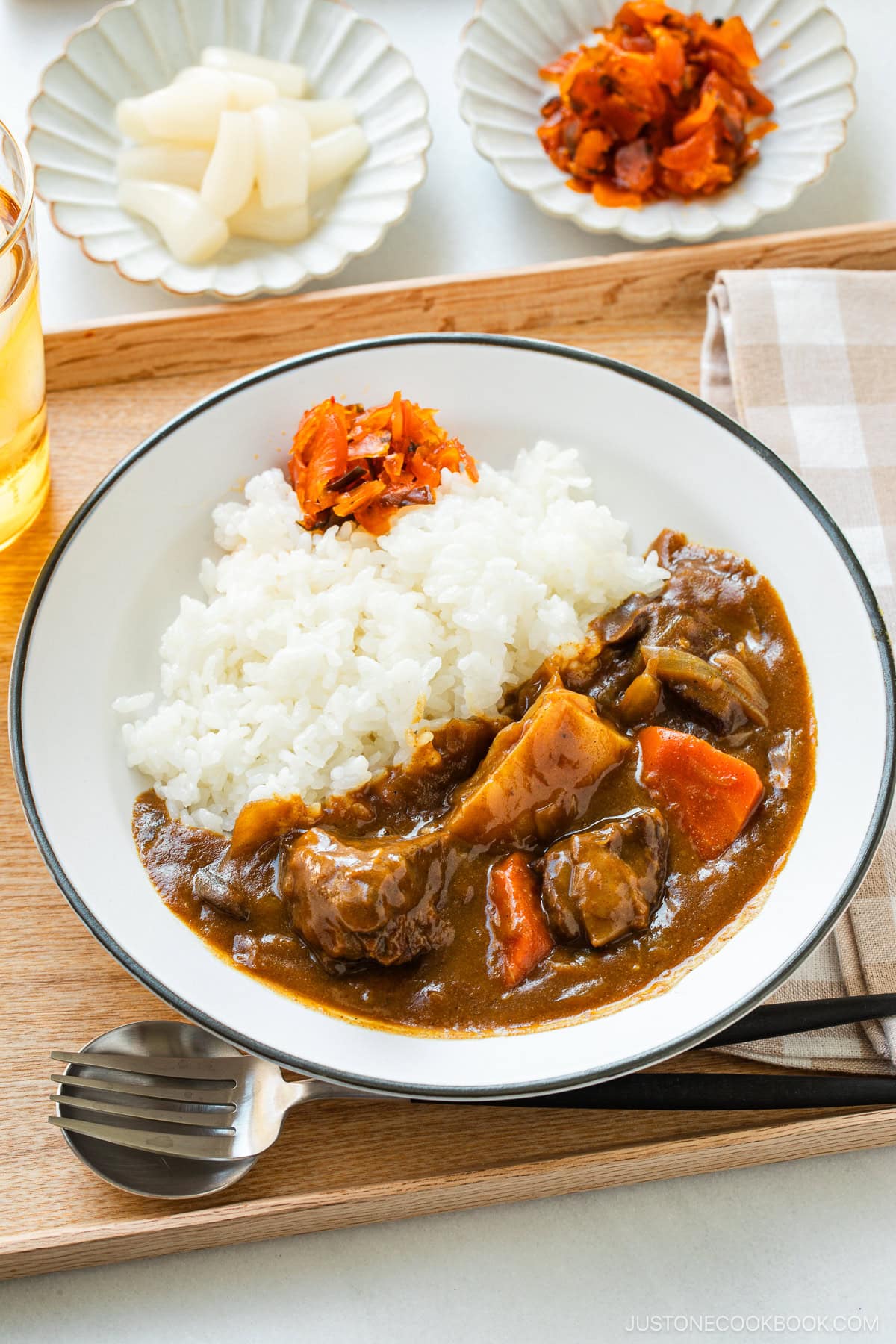
Japanese curry rice is an extremely popular dish in Japan that’s adored by young and old alike, and we consider it one of our country’s national dishes! Today, I’m bringing you a most comforting version: Japanese Beef Curry (ビーフカレー). It’s a mild and hearty stew that will satisfy your deepest craving, and I can’t wait for you to try this recipe!
Can’t get enough of Japanese curry? Try my Japanese Chicken Curry, Katsu Curry, and Pressure Cooker Japanese Seafood Curry recipes next!
What is Japanese Curry?
The British Royal Navy first introduce Indian-style curry to Japan some 150 years ago during the Meiji Restoration (1868–1912). Over time, the Japanese adapted the dish to make it milder and sweeter with a thick, rich gravy that’s ideal to serve with Japanese steamed rice. By the early 20th century, this Japanese curry rice (kare raisu, カレーライス) had become a mainstream staple; it’s now widely enjoyed in family restaurants, food halls, school cafeterias, and Japanese households throughout the country.
Table of Contents
Why I Love This Recipe
- A guaranteed family favorite! Like a chunky stew with a velvety and mild sauce, this beef curry feels like a warm hug, especially on chilly nights. My kids always have a big appetite when I make it at home.
- The most tender and flavorful meat – I’ll teach you the best cut of beef to select and how to caramelize it to amplify the flavors.
- Highly customizable – You can adjust the spice level, add local and in-season produce, and even change up the protein. See my tips below!
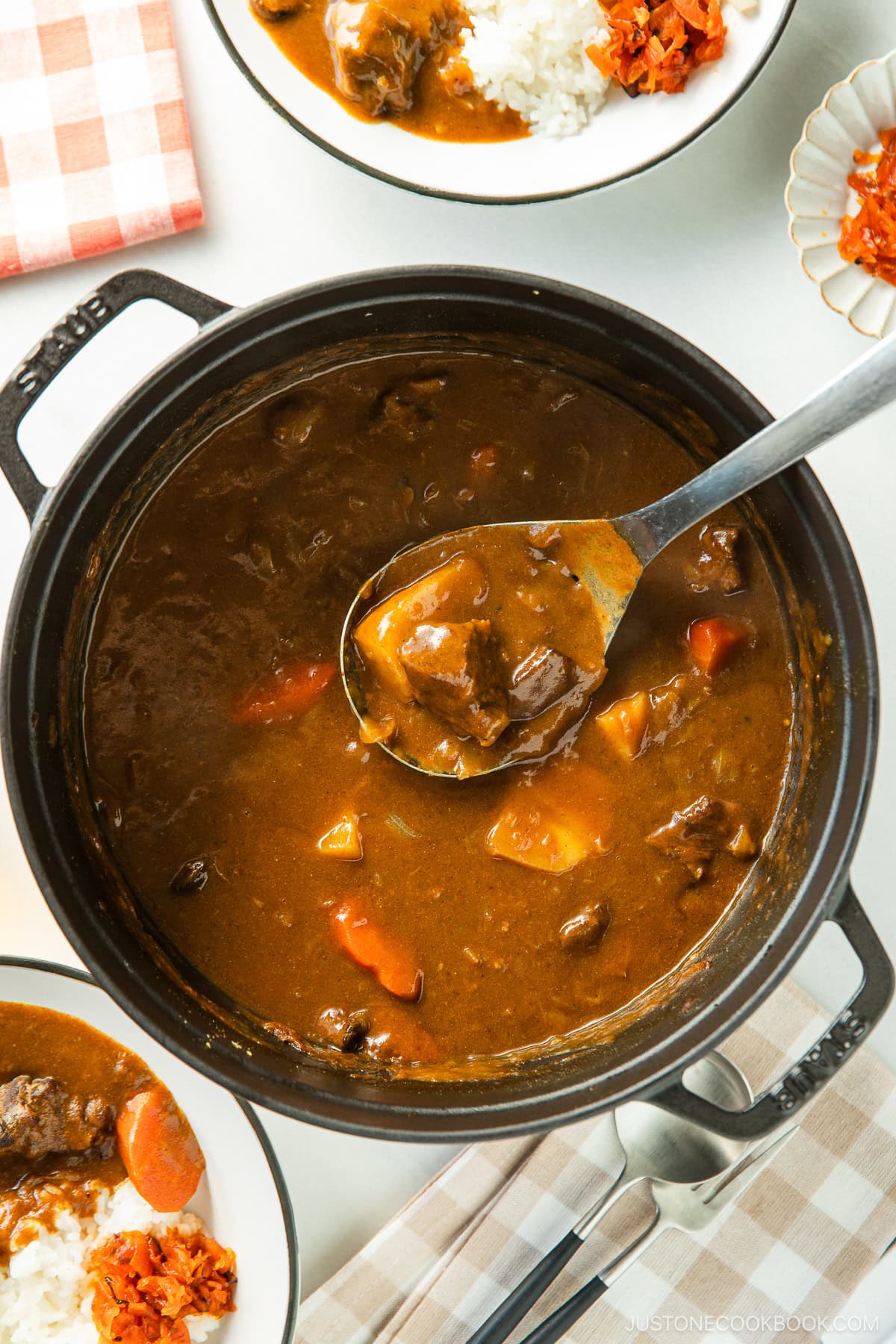
Ingredients for Japanese Beef Curry
- Beef chuck roast
- Onions
- Potatoes
- Carrots
- Mushrooms
- Garlic and ginger
- Red wine
- Curry sauce:
- Japanese curry powder
- Japanese curry roux
- Tomato paste
- Beef stock/broth
- Worcestershire sauce
- Grated apple
- Milk
- Bay leaf
- Cooked Japanese short-grain rice
Find the printable recipe with measurements below.
Jump to RecipeSubstitutions
- Beef chuck roast: I highly recommend using chuck roast, which breaks down into tender, succulent morsels after cooking low and slow. I advise against using pre-cut stew beef because it may not become as tender. If you can’t get chuck roast, I suggest finding round roast, rump roast, or pot roast.
- Japanese curry roux: Boxed Japanese curry roux is sold at Japanese and Asian grocery stores. If you can’t find it or want more control over the ingredients, I suggest making it from scratch ahead of time using my How to Make Japanese Curry Roux tutorial. You just need 5 ingredients to make my homemade recipe!
- Japanese curry powder: For an authentic taste, I highly recommend using Japanese curry powder. S&B is a popular brand. Please avoid Indian, Thai, and other pre-made curry spice blends that may have a different flavor profile than the Japanese version.
- Red wine: I love to use red wine to deglaze the pan and add a depth of flavor to the delicious curry sauce. If you can’t consume alcohol, use beef or chicken stock instead.
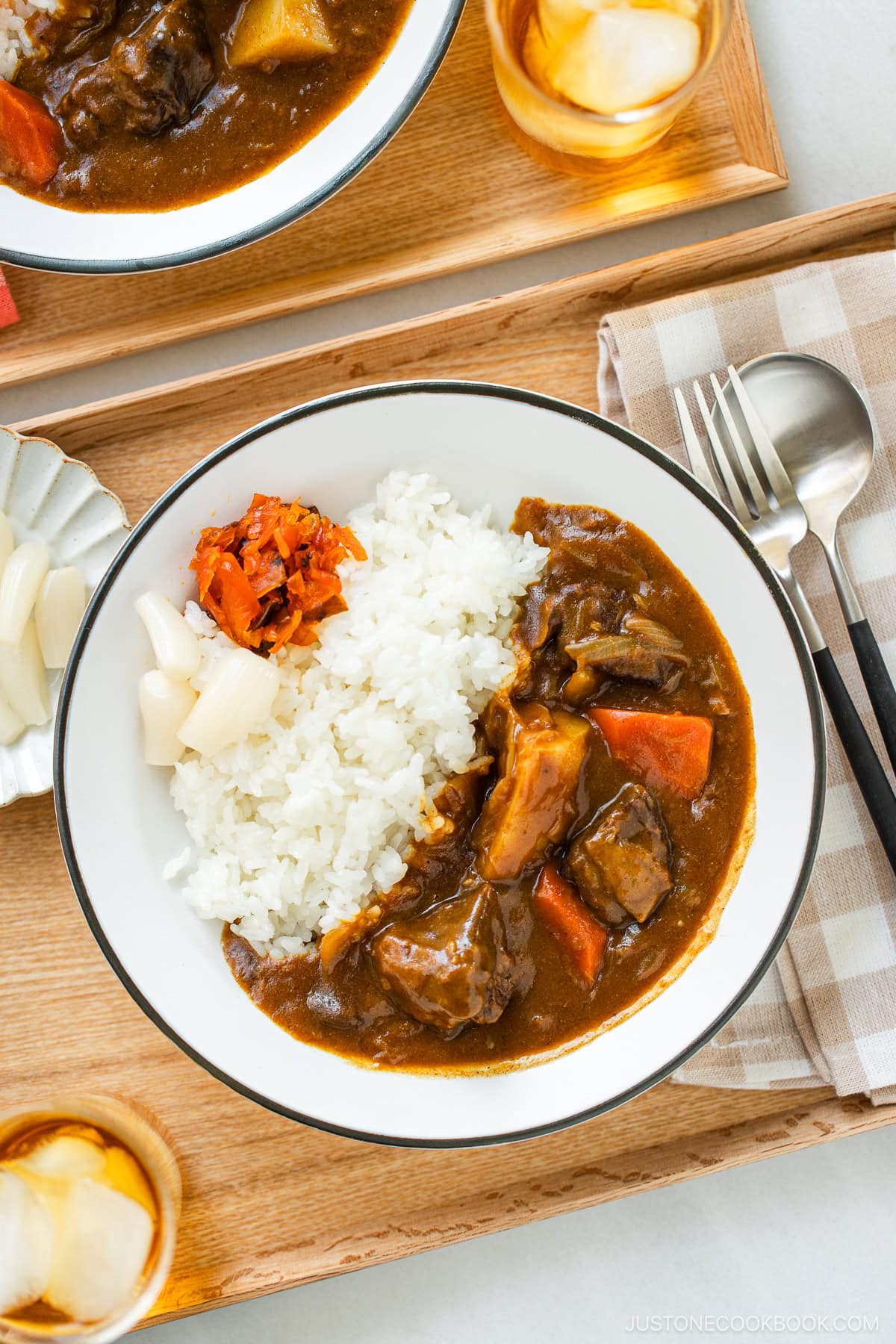
How to Make Japanese Beef Curry
Preparation
Step 1 – Thinly slice and sauté the onions. Cook them in a large, heavy-bottomed pot with some butter and oil. When the onions are caramelized, set them aside.
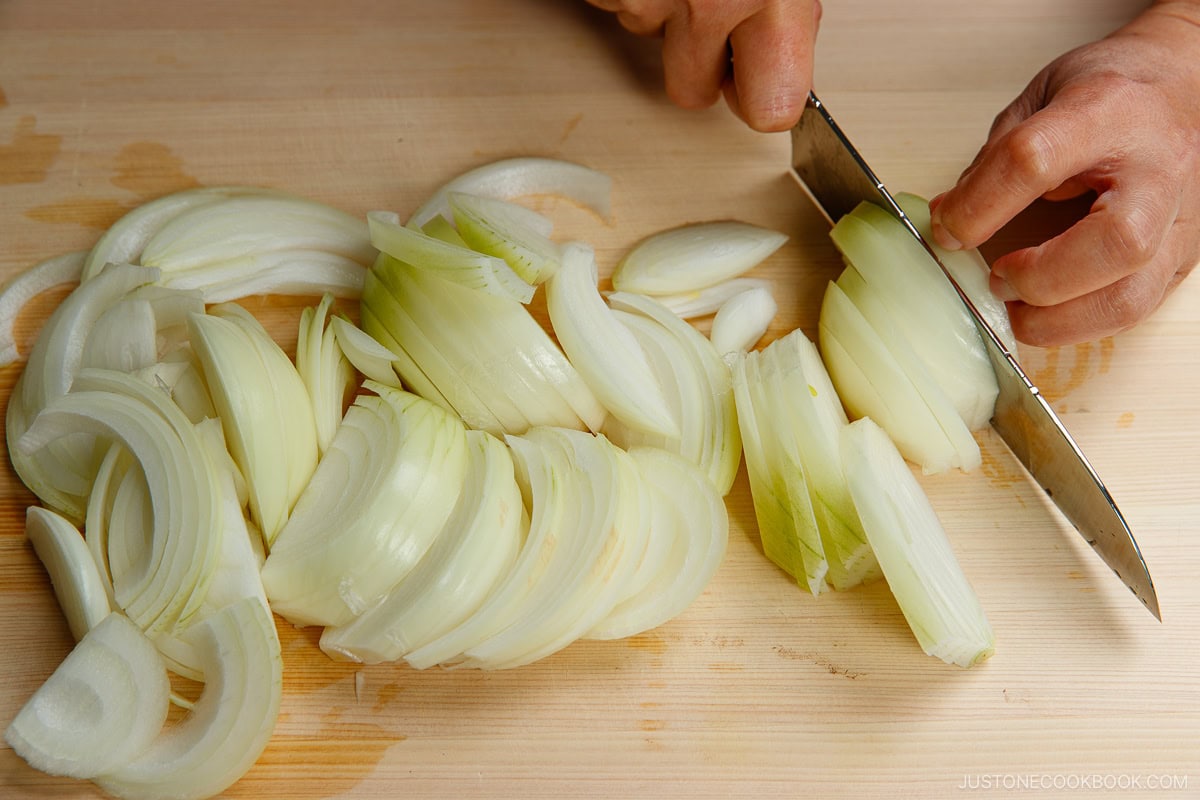
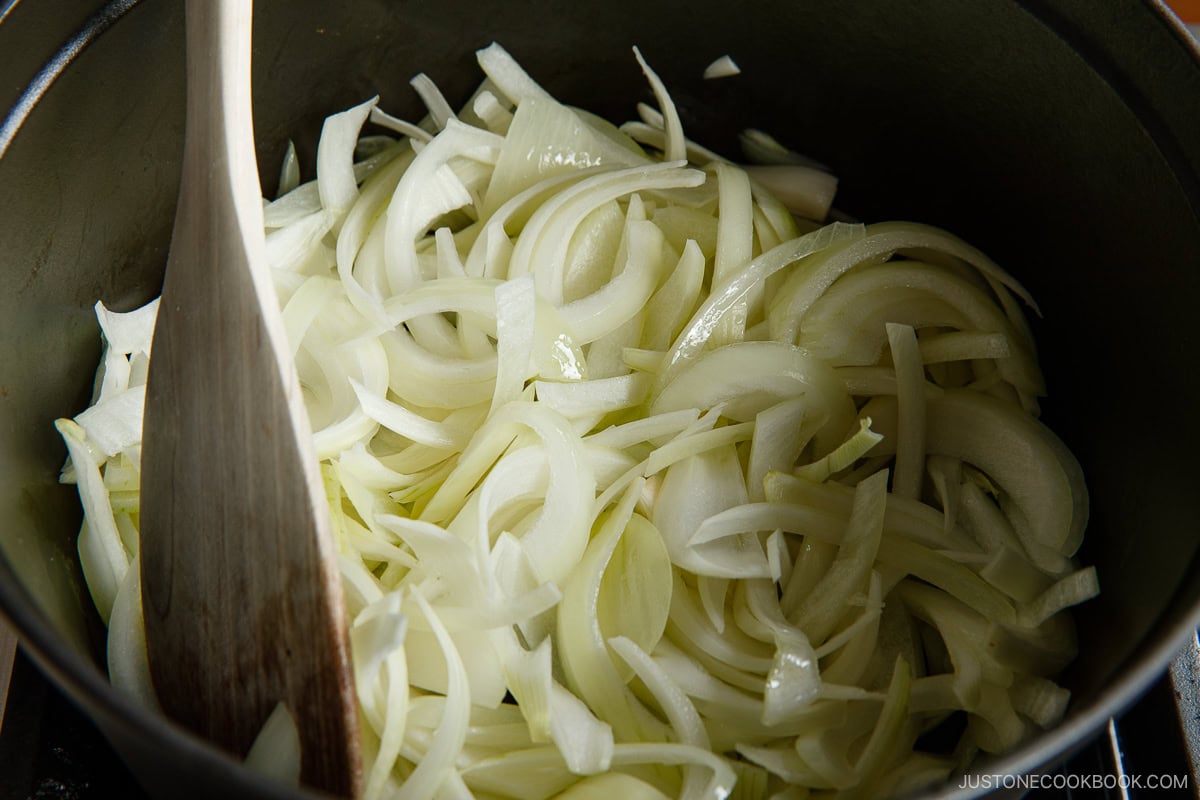
Step 2 – Prep the vegetables. Cut the mushrooms, carrots, and potato, and soak the potato chunks in water to remove the starch. Grate the ginger and mince the garlic.
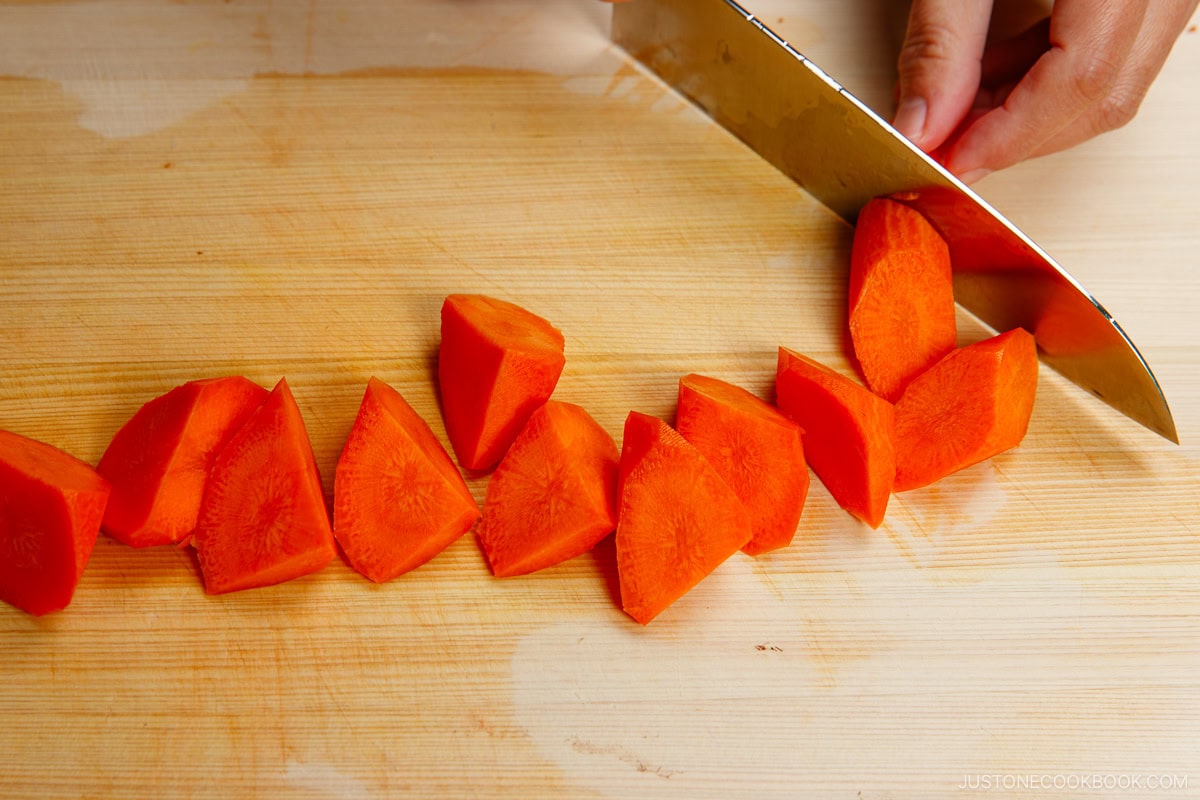
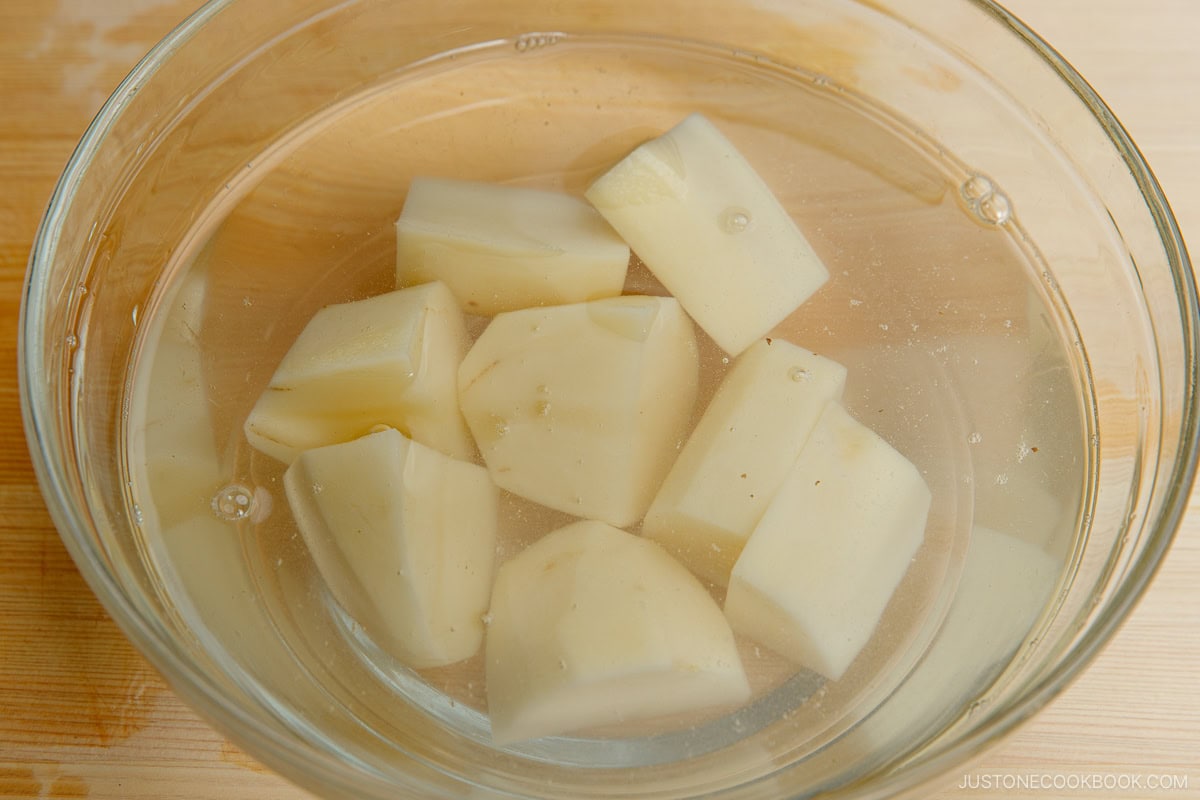
Step 3 – Cut the meat and season it. Cut the beef chuck roast into large cubes. Sprinkle with salt and pepper and lightly coat the meat on all sides with flour.
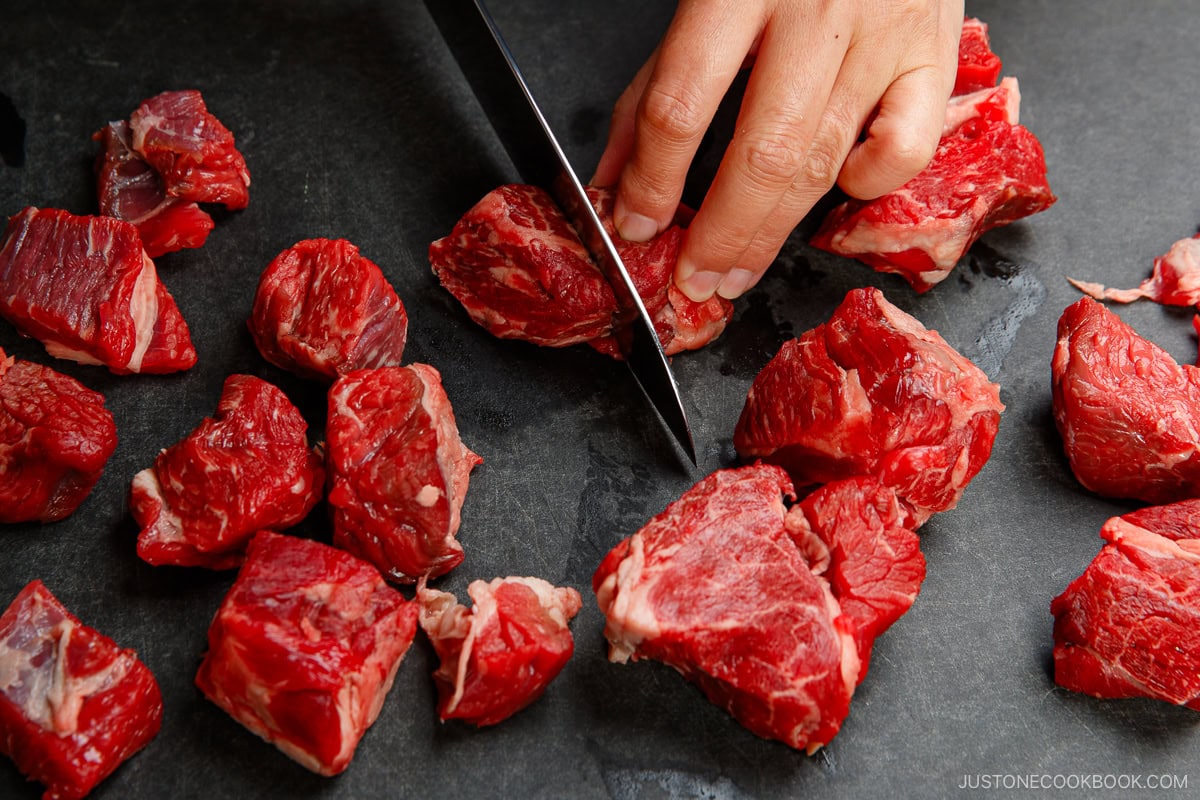
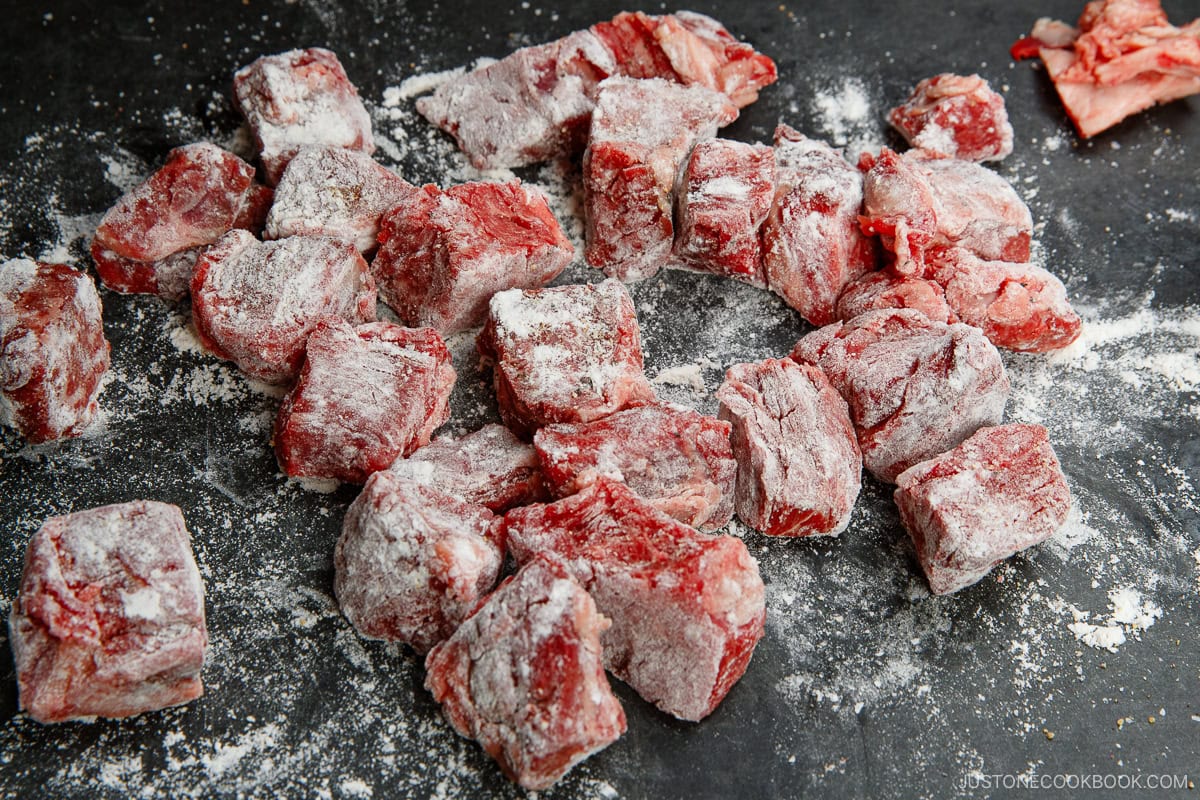
Cooking
Step 4 – Sear the beef and deglaze the pan. Add the beef cubes in two batches to a pan preheated over medium-high heat. Sear on all sides until brown and crusty and remove to a plate. Deglaze the pan with the red wine, scraping up the delicious browned bits with a wooden spatula.
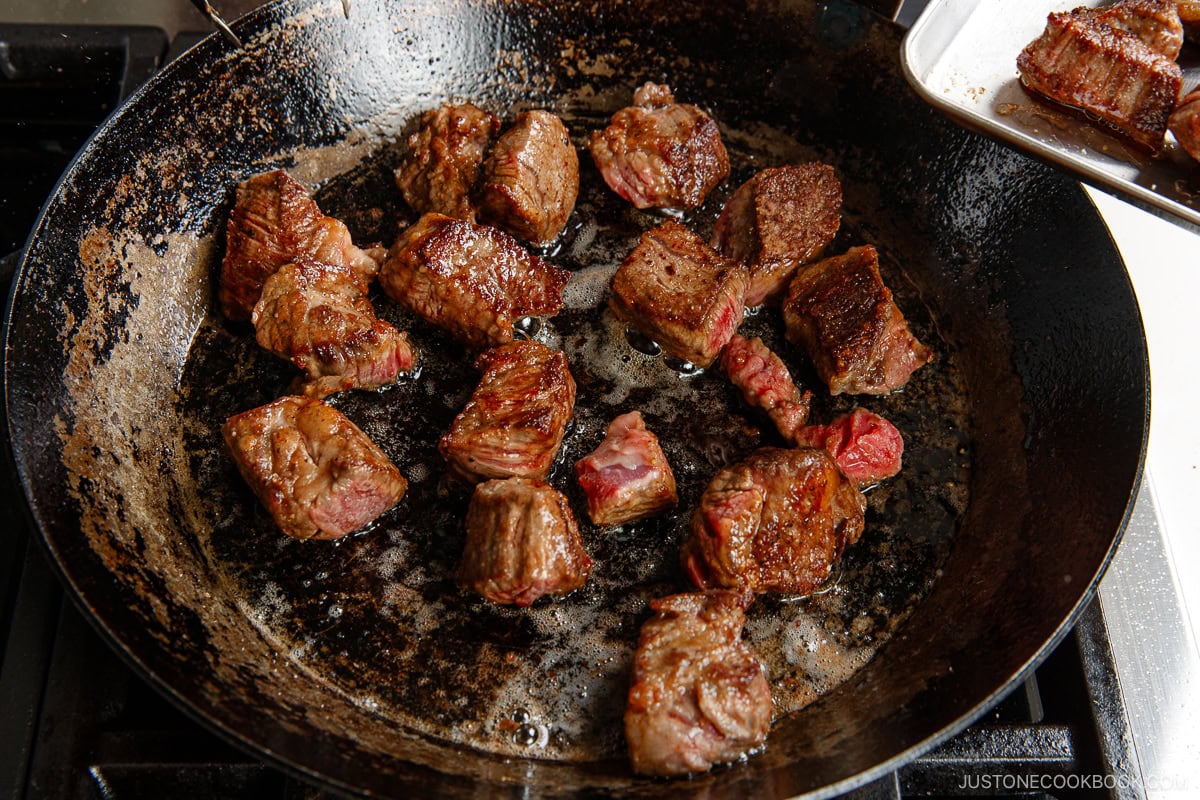
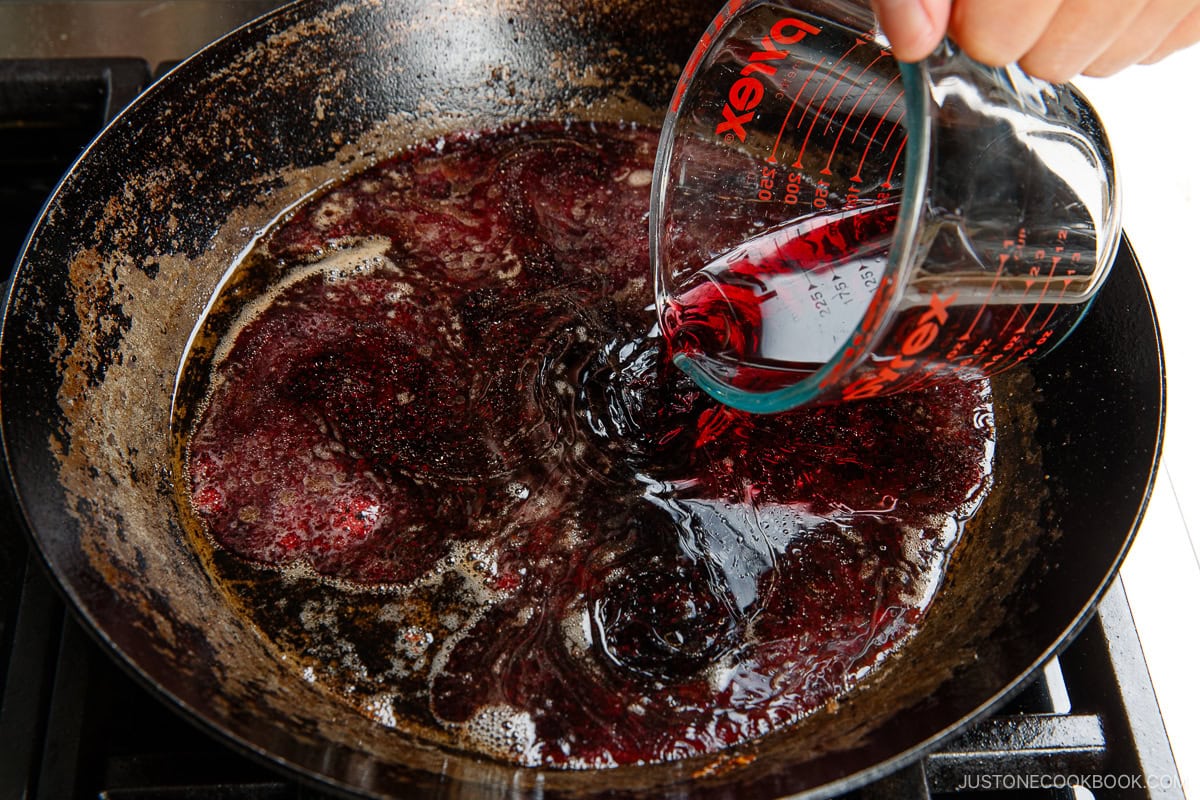
Step 5 – Add the seasonings to the caramelized onions. Add the garlic, ginger, curry powder, and tomato paste to the caramelized onions. Stir and sauté for a minute.
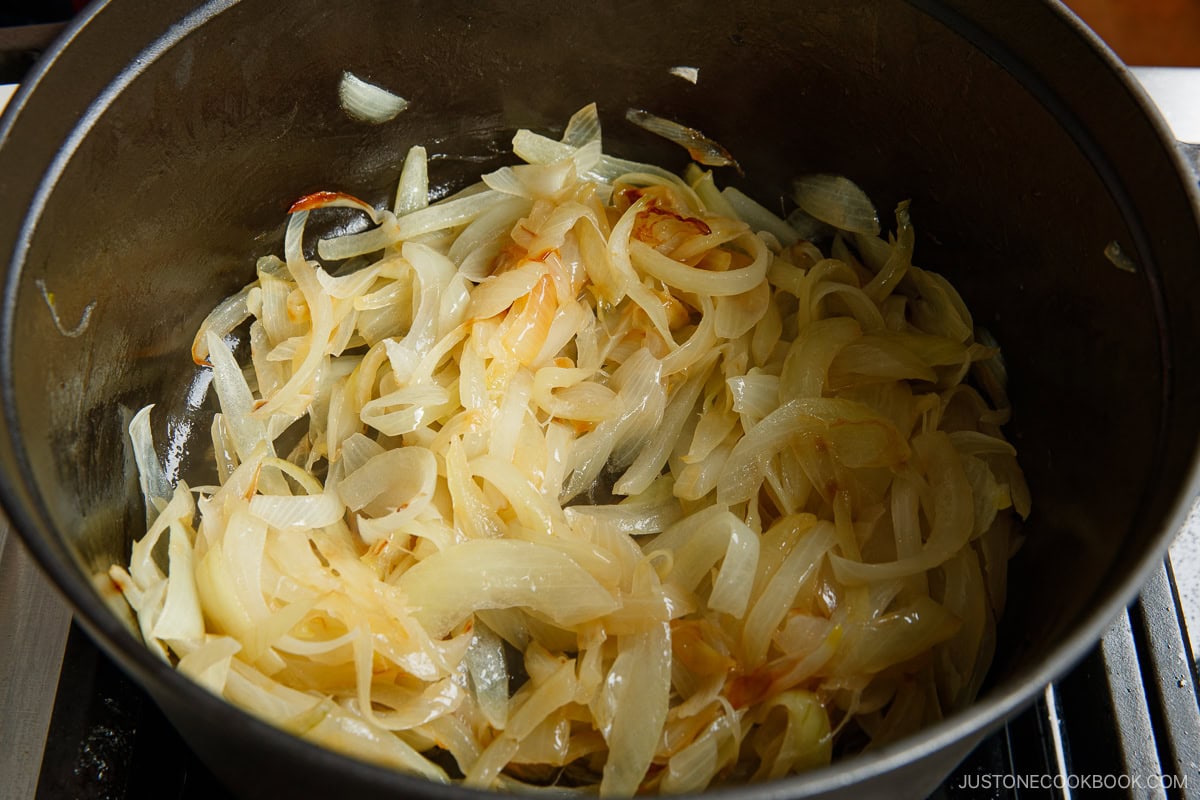
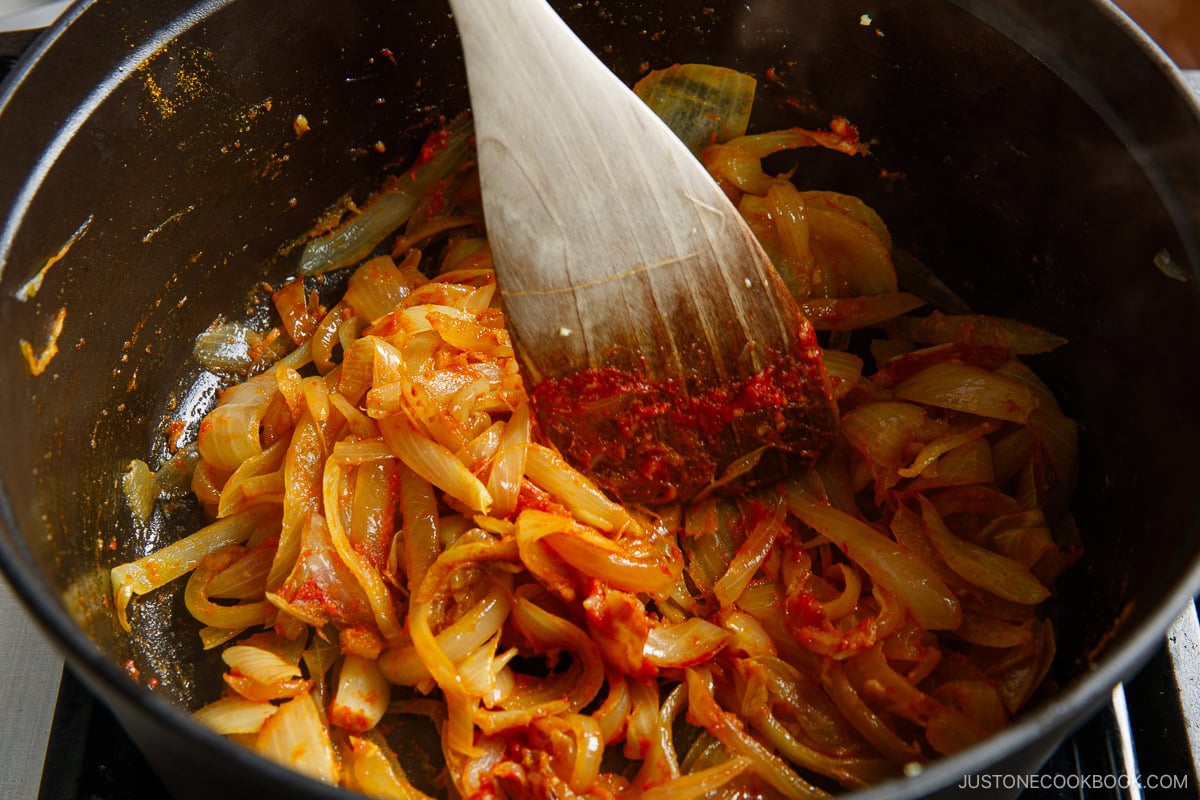
Step 6 – Add the meat and pan liquid. Add the seared beef with juices and the deglazed pan liquid to the onions in the pot. Mix together and cook to allow the alcohol from the wine to evaporate further.
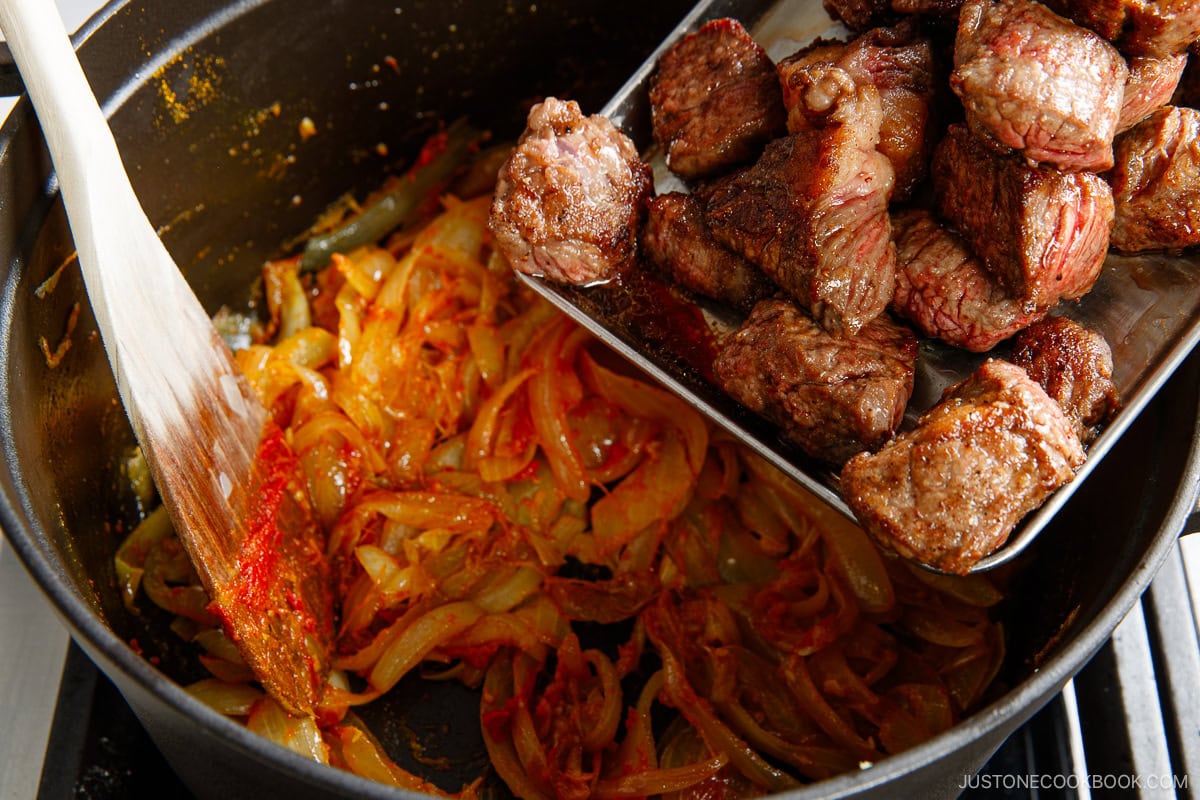
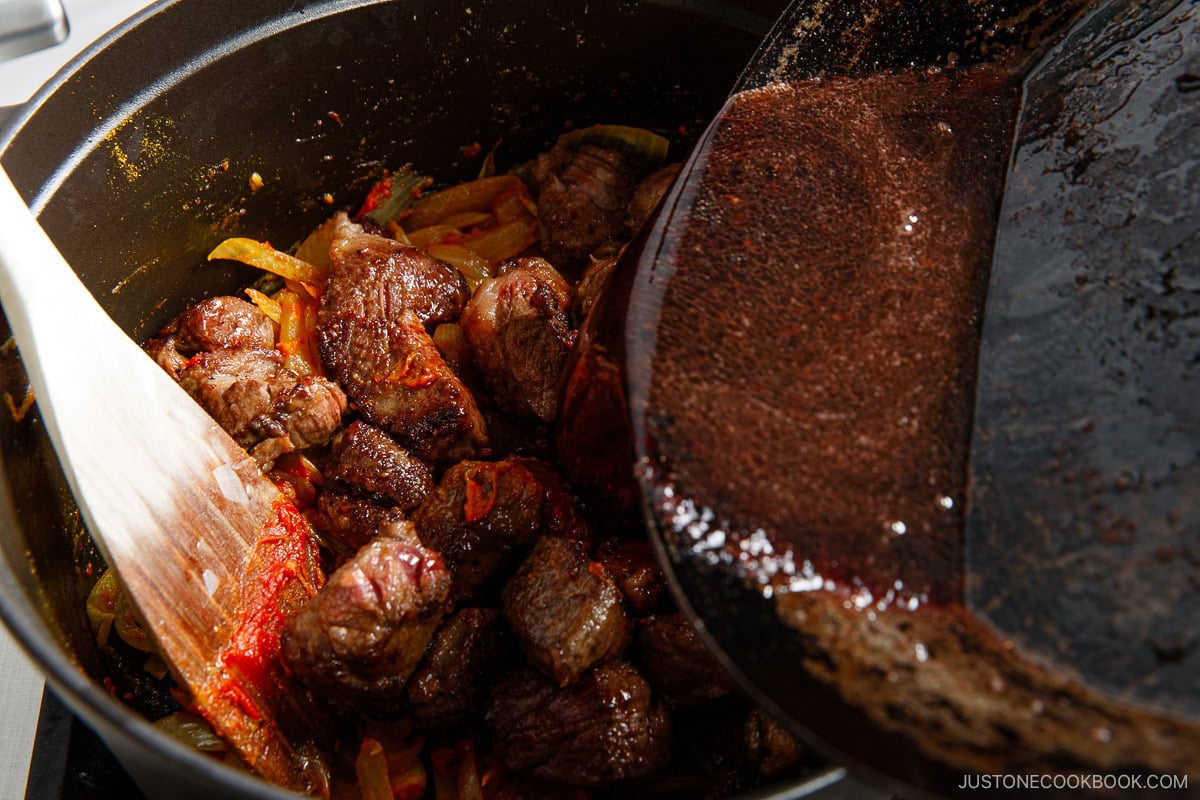
Step 7 – Simmer low and slow, then add the potatoes and curry roux. Add the carrots, mushrooms, beef stock, apple, Worcestershire sauce, and milk. Simmer until the beef is tender, then add the potatoes to cook through. Dissolve the curry roux into the stew off the heat, then cook on the lowest heat until the sauce thickens.
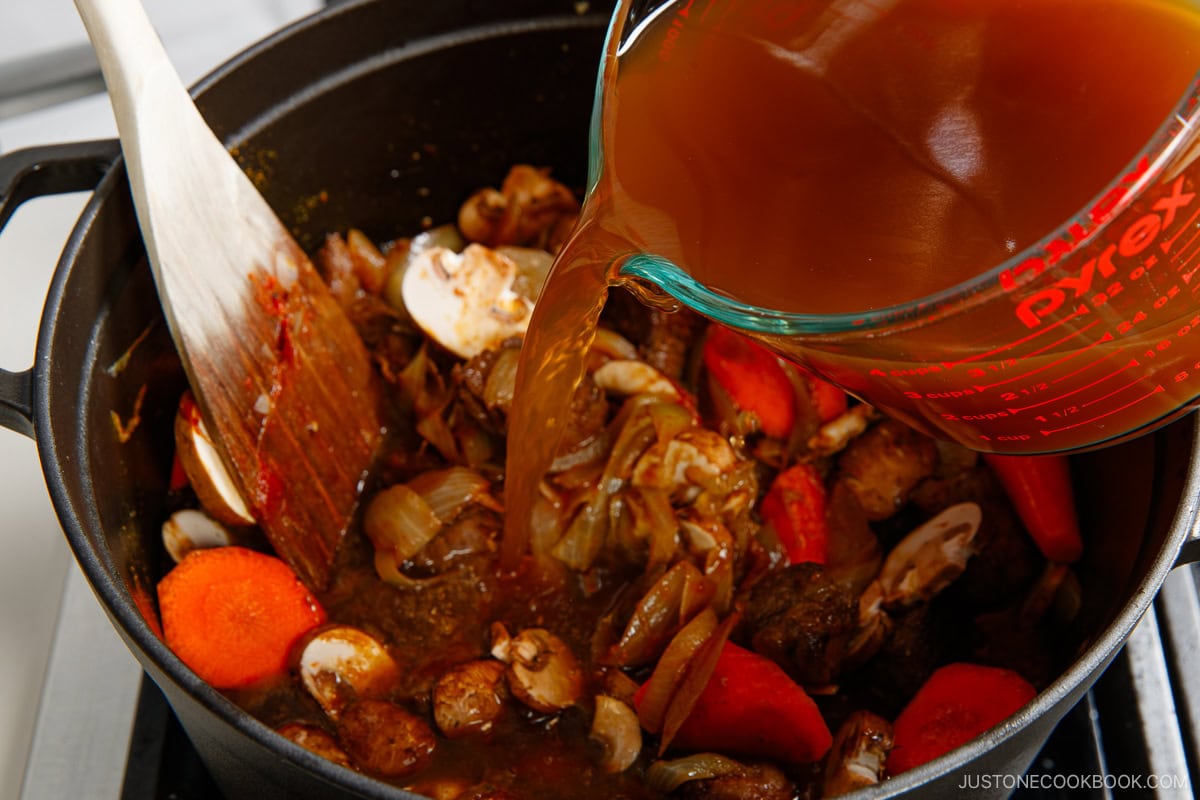
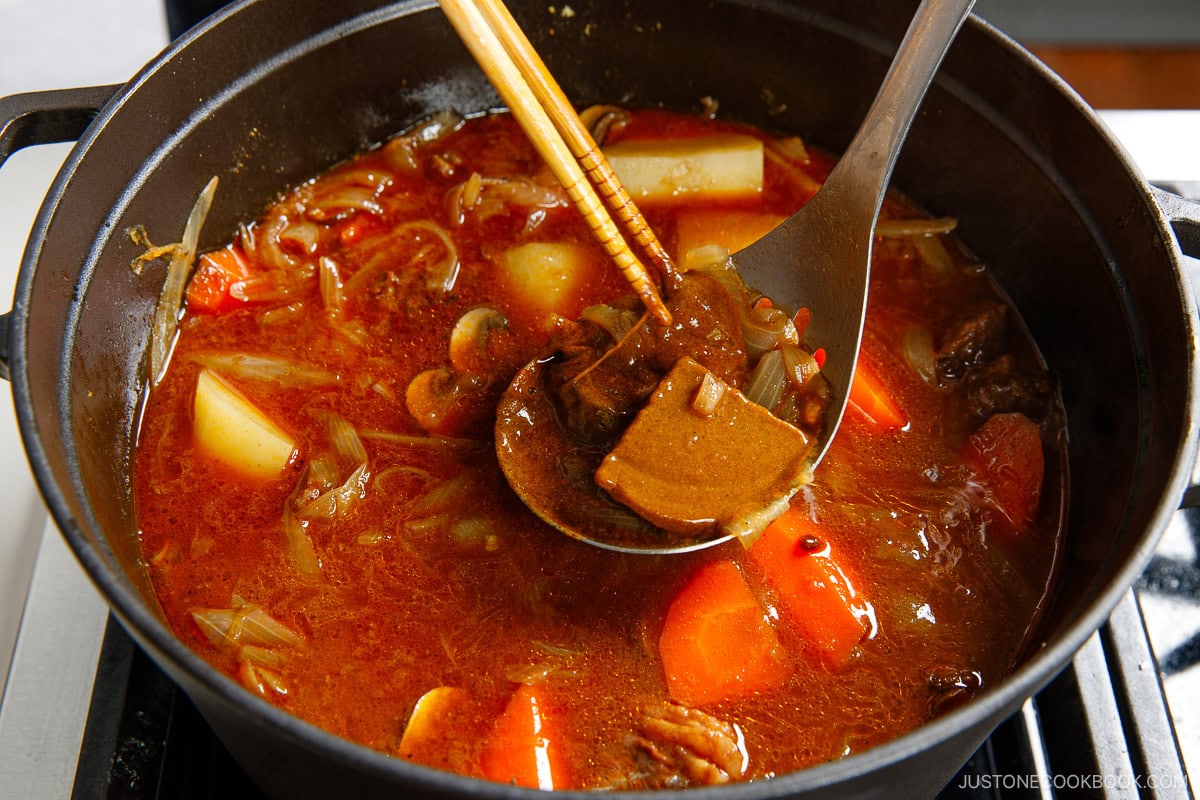
Step 8 – Serve. Portion a serving of Japanese steamed rice on one half of an individual plate or pasta bowl and spoon the Japanese beef curry on the other half. Garnish with Japanese pickles and enjoy!
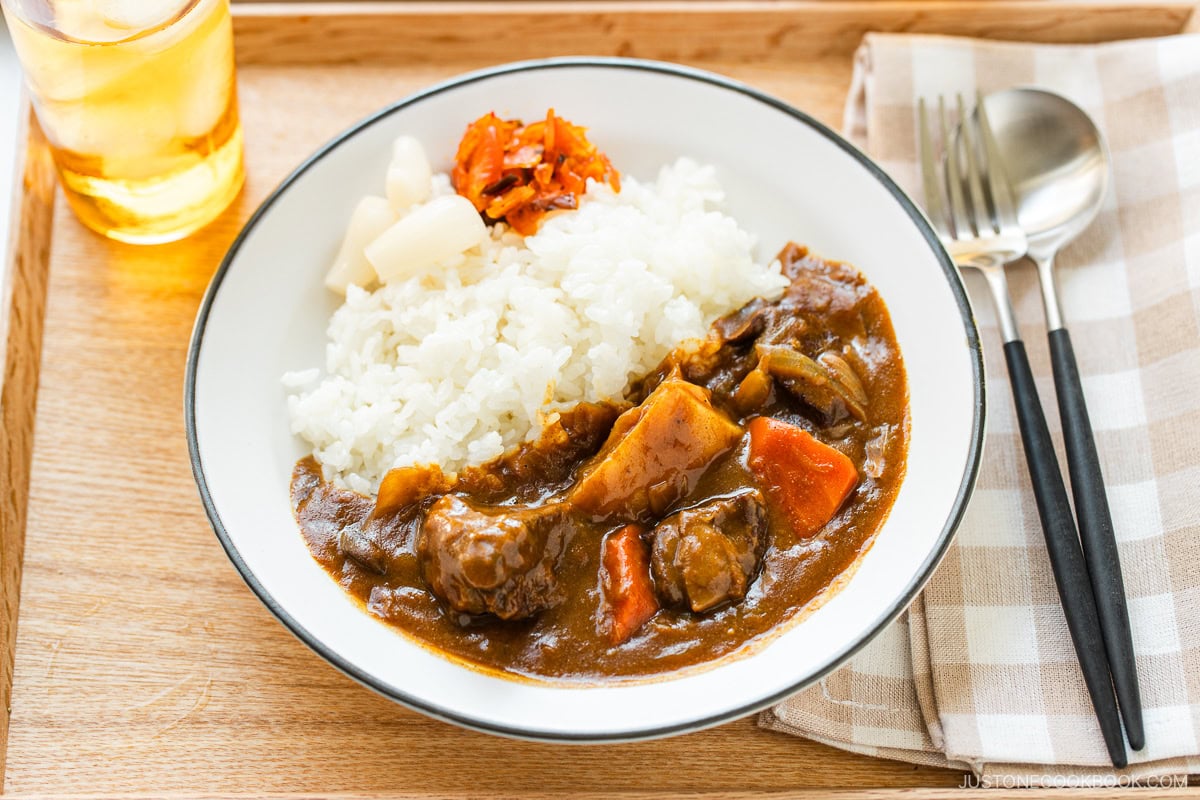
Nami’s Recipe Tips
- Use chuck roast instead of stew beef – For the most tender beef for your Japanese curry, I strongly recommend using chuck roast. This cut is from the shoulder muscles, and while it’s initially quite tough, it becomes tender and succulent once cooked low and slow. Meanwhile, stew beef is made up of random pieces leftover from trimming other cuts, so you can’t be sure how your final dish will turn out. As I mentioned earlier, I suggest round roast, rump roast, or pot roast as alternatives if you can’t find chuck roast.
- Sear the meat – This is an crucial step for the most flavorful meat and I consider it essential. Searing caramelizes the natural sugars in the meat and browns the proteins, forming a bronze crust on the surface that amplifies the savory flavor of the finished dish. You’ll be rewarded with a rich, savory curry sauce with the most delicious morsels of meat.
- Caramelize the onions – When you sauté the onions over an extended period of time, the natural sugars in the onions caramelize, bringing out their sweetness and making them extremely flavorful. I know it takes time, but this extra step will add so much depth to your dish. I always use that time to get the other prep work done.
- Cook the beef low and slow – For really tender meat, it usually takes two hours. Please do not rush the cooking process. Otherwise, the beef will be tough and chewy. Make sure there’s enough liquid in the pot and keep an eye on the dish.
- Add the potatoes 15 minutes before finishing – I like to add the russet potatoes toward the end of the 2-hour simmer. That way, the potatoes will keep their shape instead of disintegrating into the sauce. While you could use Yukon gold potatoes, which tend to keep their shape, I like the floury, light, and fluffy texture of russet potatoes for the curry.
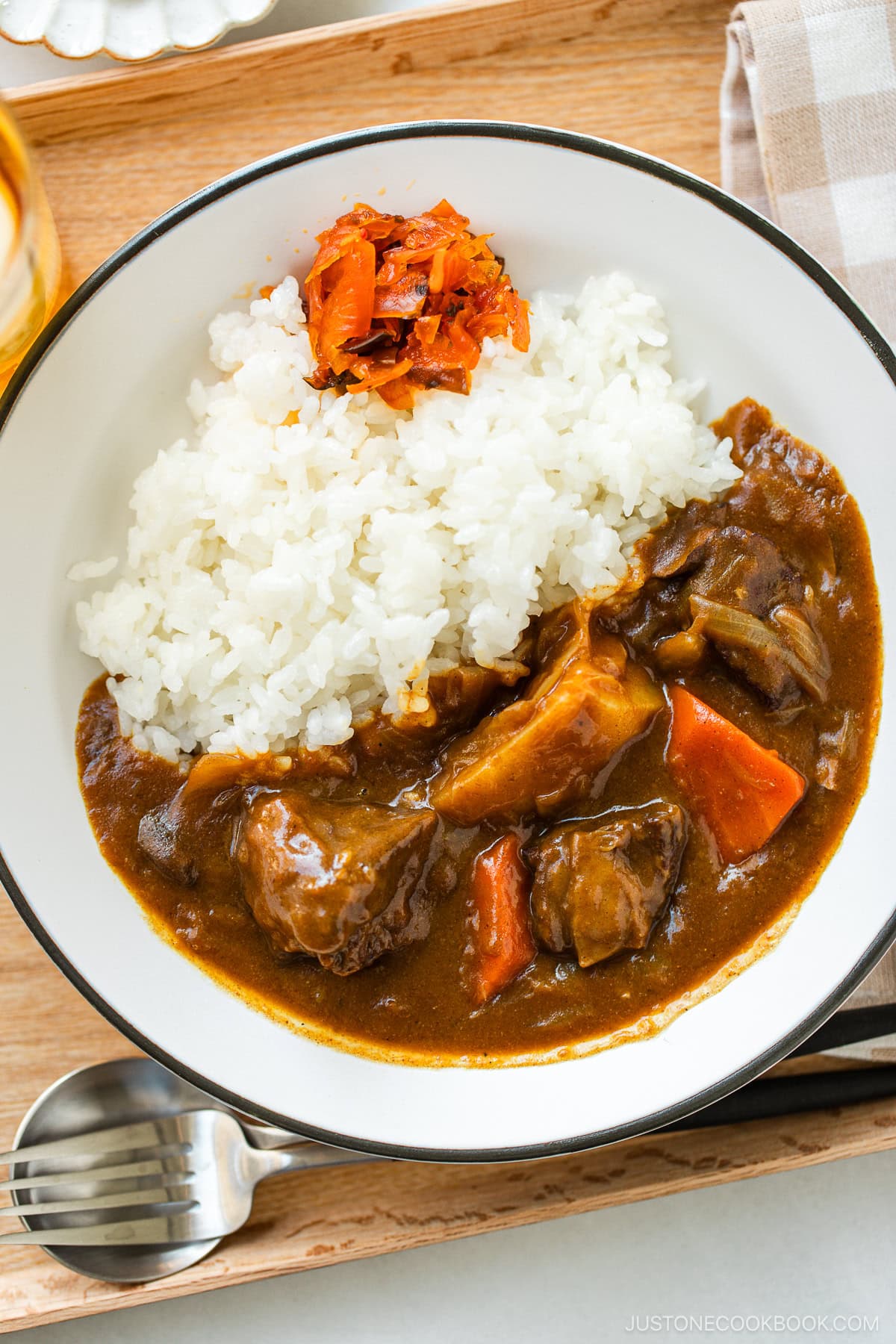
Variations and Customizations
The beauty of Japanese curry is its room for customization. Every cook has the freedom to enhance and personalize the flavors with different ingredients (some can be unexpected).
- Change the protein. Instead of beef chuck roast, try using chunks of chicken thighs or bone-in pieces of dark meat chicken. You could also use thin-sliced pork belly for a luxurious and quick-cooking option. I also like to make mixed seafood curry with shrimp, clams, calamari, and scallops.
- Use your favorite vegetables and mushrooms. In Japan, we often customize our curry ingredients with what’s in season or growing in our vegetable garden. Different regions also make specialty curries based on their locally-grown produce. I encourage your to personalize your curry with your favorite vegetables like Japanese eggplants, tomatoes, okra, asparagus, kabocha, lotus root, and sweet bell peppers and other types of mushrooms like shimeji and king oyster varieties.
- Enhance the taste with flavor boosters. In today’s recipe, I’ve already included a few of my favorite add-ins—grated apple, garlic, ginger, milk, red wine, and Worcestershire sauce—to enrich my curry sauce. You can change these up and use other ingredients like honey, ketchup, butter, soy sauce, and tonkatsu sauce.
- Make it vegetarian. Japanese curry usually includes a protein of your choice (typically beef, chicken, pork, or seafood), onions, potatoes, and carrots. For a vegetarian option, you can add firm tofu right before you serve just to heat it through. Or make my Vegetarian Japanese Curry that is packed with a colorful medley of veggies!
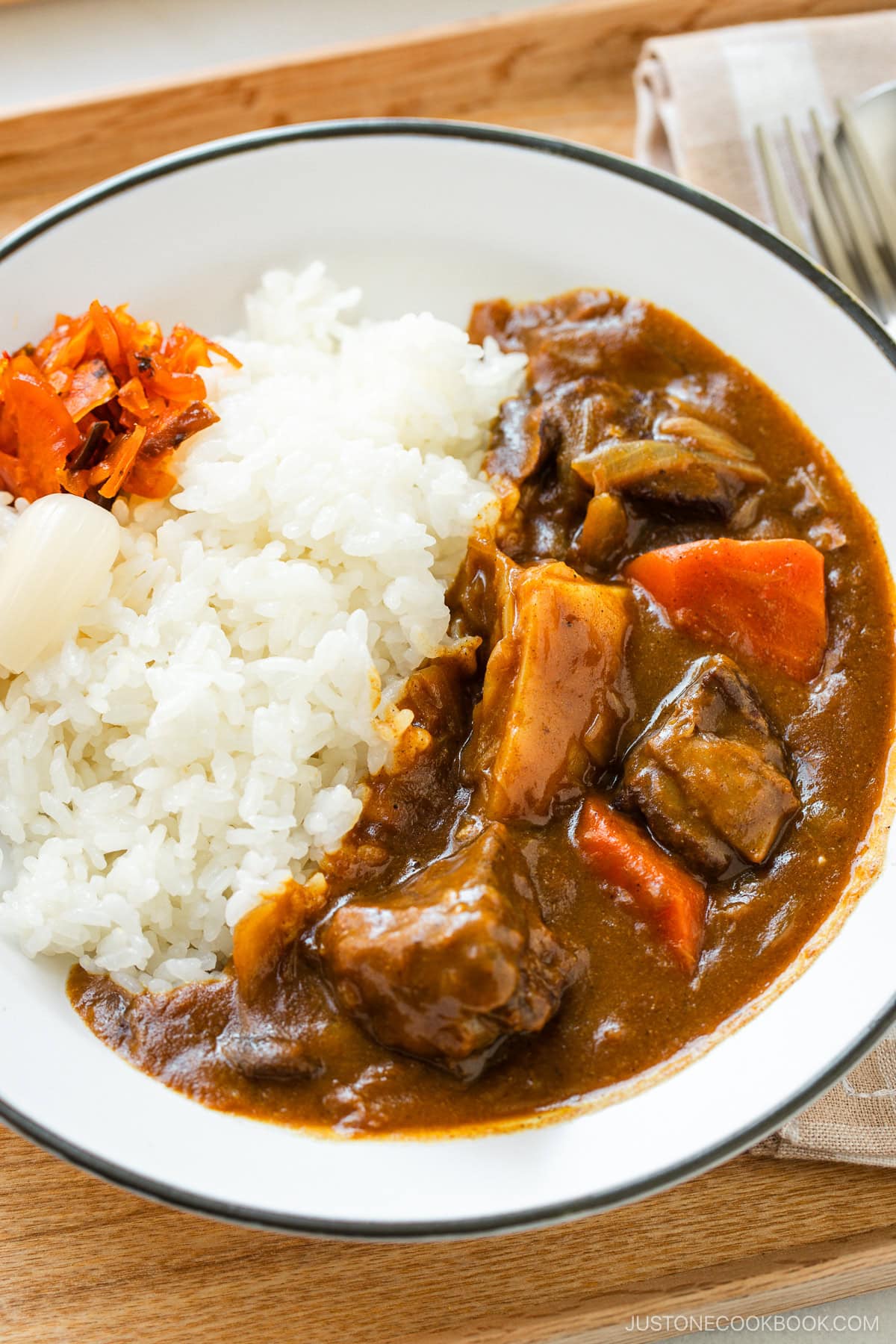
What to Serve with Japanese Beef Curry
- With Japanese pickles – I always serve curry rice with pickles on the side, and the classic choice is crunchy, tart, and sweet Homemade Fukujinzuke (Japanese pickles for curry) and rakkyō (Japanese pickled scallions).
- With a light salad – I love to serve it with a refreshing side salad like Asian Coleslaw with Sesame Dressing. or Japanese Macaroni Salad.
- With a cold beverage – Mugicha (Japanese Barley Tea) is a traditional caffeine-free drink with a crisp and roasted flavor that I often serve to my whole family.
Storage and Reheating Tips
To store: Store leftovers in an airtight glass container in the refrigerator for up to 3 days or in the freezer for up to a month. However, I recommend removing the potatoes as the texture will change after freezing.
To reheat: Defrost the frozen curry in the refrigerator for 24 hours and gently reheat in a pot to serve. If needed, gradually add ½ cup (120 ml) of water or more to dilute the curry when reheating.
Frequently Asked Questions
Absolutely! You can follow my Instant Pot Pressure Cooker Japanese Curry recipe to make the beef version as well.
You may have used the wrong cut of meat or didn’t cook it long enough. First, I recommend using chuck roast instead of stew beef. Beef stew meat is typically made up of odds and ends from various cuts. Chuck roast, while quite tough initially, becomes melt-in-your-mouth tender after being cooked low and slow.
Second, be sure to cook it for 2 hours, as is standard in all beef stew recipes. Do not rush the process; otherwise, the beef will turn out tough and chewy. Make sure there’s enough liquid in the dish and keep an eye on it while cooking. You can also use my Instant Pot method if you prefer to save time.
When simmering stews like this for an extended period, it’s important to use a heavy-bottomed pot with a tight-fitting lid. I use a 5.5QT Staub Cast Iron Dutch Oven, and its lid seals perfectly. Le Creuset is a good option as well, but I’ve noticed some evaporation due to a slight gap between the lid and the pot.
More Comforting Japanese Curry Recipes
If you enjoy curry dishes, I would love for you to try out these easy and popular recipes:
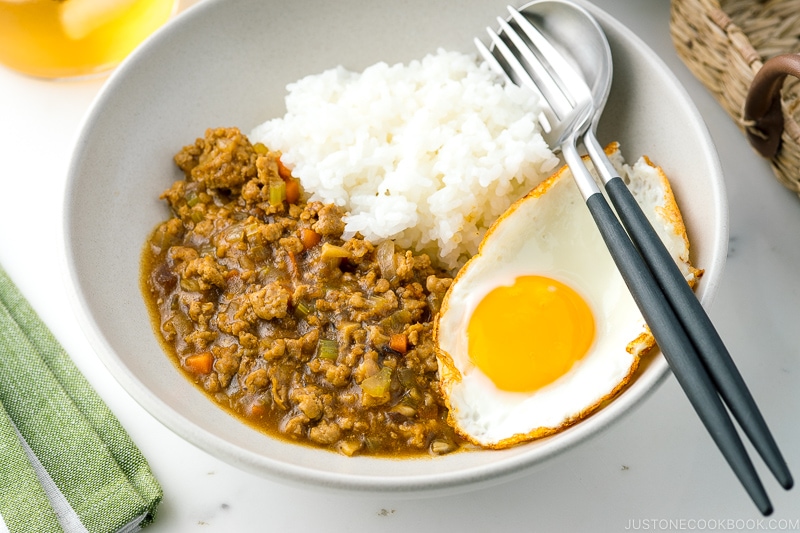
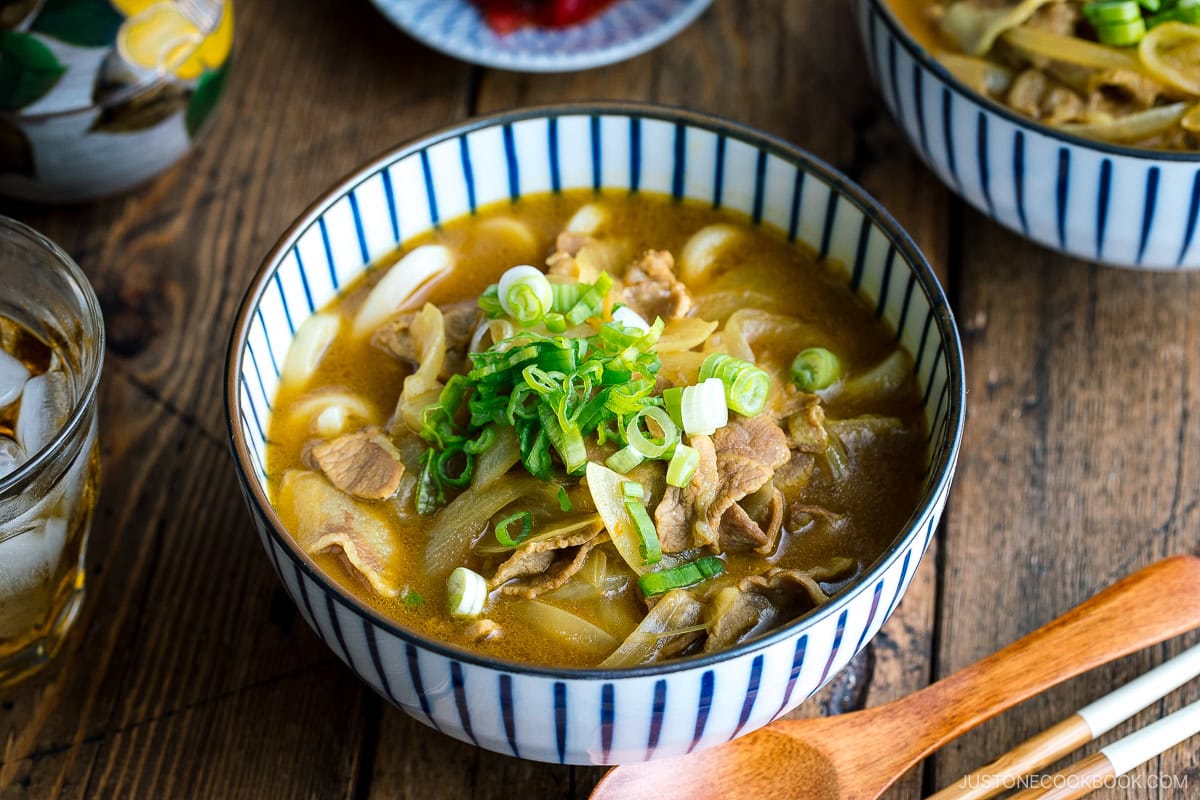
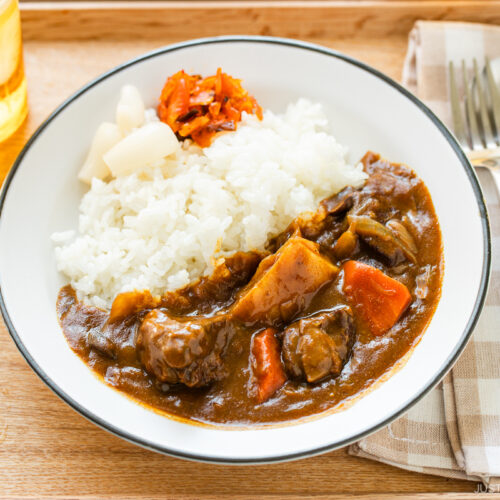
Japanese Beef Curry
Video
Ingredients
- 2 onions (large; 1¼ lb, 567 g)
- 2 Tbsp unsalted butter (divided)
- 2 Tbsp neutral oil (divided)
- 1 russet potato (11 oz, 309 g)
- 1 carrot (large; 8 oz, 230 g)
- 6 cremini mushrooms (2.6 oz, 80 g)
- ½ tsp ginger (grated, with juice)
- 1 clove garlic (minced)
- 1¼ lb boneless beef chuck roast
- ¼ tsp Diamond Crystal kosher salt
- ¼ tsp freshly ground black pepper
- 1 Tbsp all-purpose flour (plain flour)
- ½ cup red wine
For the Curry Sauce
- ½ Tbsp Japanese curry powder
- 1 Tbsp tomato paste (or ketchup)
- 4 cups beef stock/broth (1 QT; for lower sodium, use water only or half stock and half water)
- ⅛ apple (plus more for sweetness; I use Fuji apple; or substitute 1 Tbsp honey or mango chutney)
- 1 Tbsp Worcestershire sauce
- 2 Tbsp milk
- 1 bay leaf
- 1 package Japanese curry roux (7–8.4 oz, 200–240 g; or make my Japanese Curry Roux)
For Serving
- 8 servings cooked Japanese short-grain rice (1–1½ cups, 180–270 g per serving)
- fukujinzuke (Japanese red pickled vegetables) (optional; make my Homemade Fukujinzuke)
- rakkyo (Japanese pickled scallion) (optional)
Instructions
- Gather all the ingredients. Please note that 4 rice cooker cups (720 ml, 3 cups, 600 g) of uncooked rice yield 8¾ cups (1320 g) of cooked rice, enough for 5–8 servings for Japanese curry rice. See how to cook short-grain rice with a rice cooker, pot over the stove, Instant Pot, or donabe.
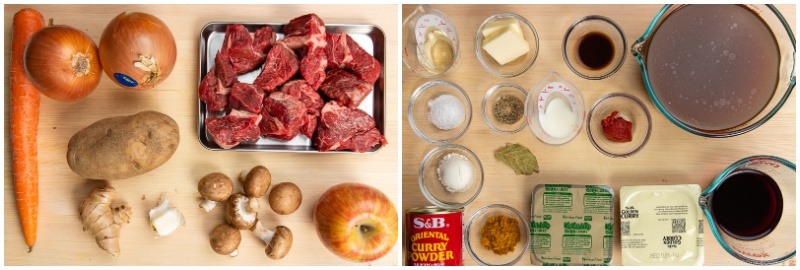
To Caramelize the Onions
- Cut 2 onions into thin slices.
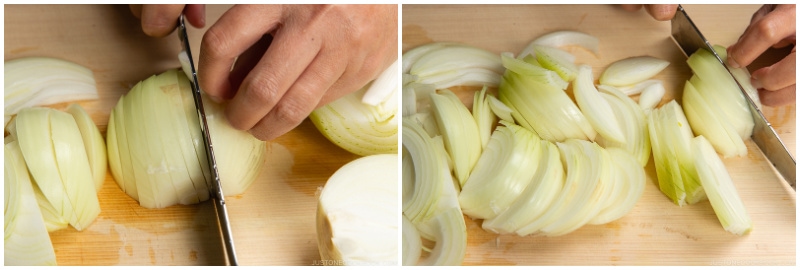
- Preheat a large heavy-bottomed pot (I used a 5.5 QT Staub Dutch oven) on medium heat. When the pot is hot, add half of the 2 Tbsp unsalted butter, half of the 2 Tbsp neutral oil, and the onions to the pot. Stir to coat the onions.
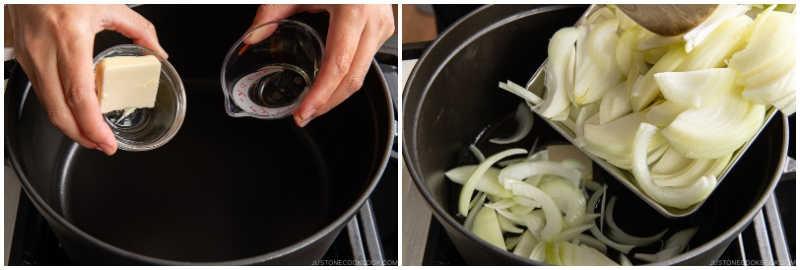
- Sauté the onions, stirring occasionally, for about 20–25 minutes. Meanwhile, move on to the next step (but stir the onions and keep an eye on them). When the onions are wilted, reduce the stove‘s heat to medium low (as they tend to burn quickly) and keep cooking. Once the onions are tender, translucent, and a bit caramelized, remove the pot from the heat and set aside until the beef is done searing.
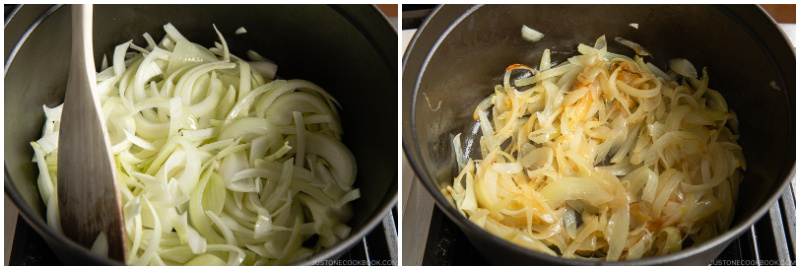
To Prepare the Other Ingredients
- While the onions are sautéing, peel and cut 1 russet potato in thirds.
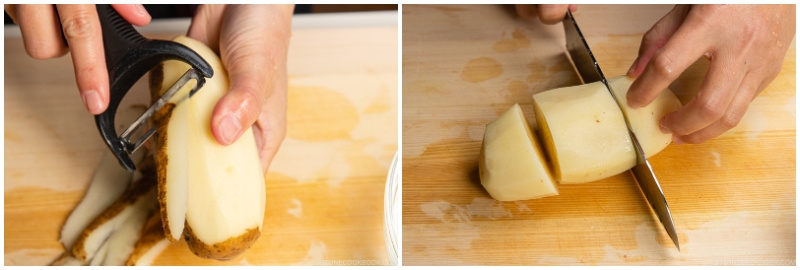
- Then, cut each piece in half or quarters. To remove the starch, soak the potato pieces in a bowl of water for 15 minutes or until it's time to add them to the pot later on.
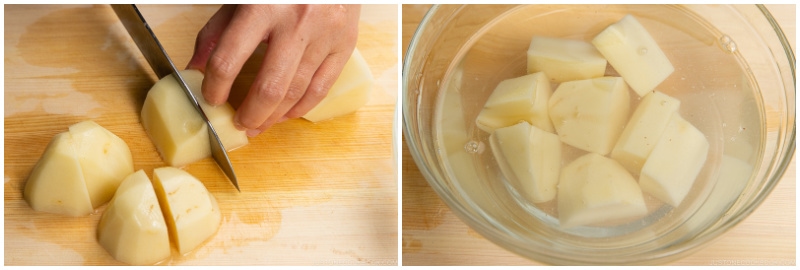
- Peel and cut 1 carrot diagonally while rotating it a quarter turn between slices to make random cuts. We call this cutting technique rangiri in Japanese.
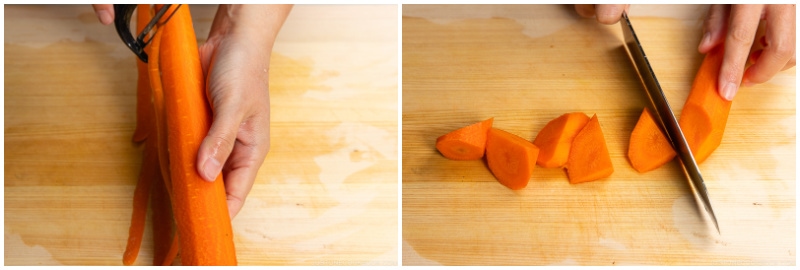
- Clean 6 cremini mushrooms and cut them into thin slices. Tip: I use a pastry brush and avoid washing mushrooms as they absorb moisture. However, it‘s okay to quickly rinse them.
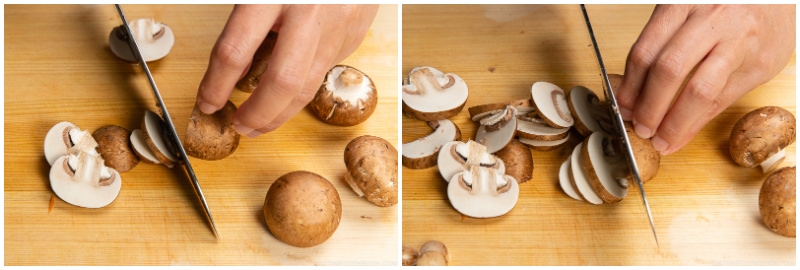
- Grate the ginger (I use a ceramic grater) and measure ½ tsp ginger (grated, with juice). Set aside. Then, mince 1 clove garlic (I skip it here as I use a garlic press later).
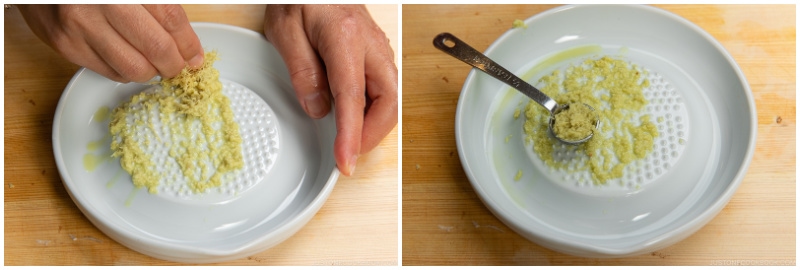
- Cut 1¼ lb boneless beef chuck roast into 1½-inch (3.8 cm) cubes. Tip: I recommend chuck roast for its tenderness and higher quality. While stew beef is slightly more economical, I don't recommend it because it‘s made up of bits and pieces leftover from carving various cuts, so the meat is not as tender.
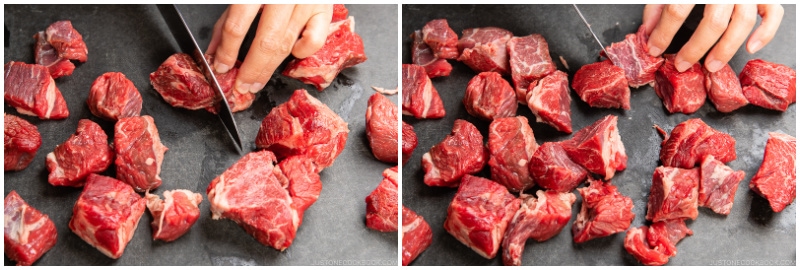
- Lightly sprinkle the beef with ¼ tsp Diamond Crystal kosher salt and ¼ tsp freshly ground black pepper. Then, lightly coat the meat on all sides with 1 Tbsp all-purpose flour (plain flour).
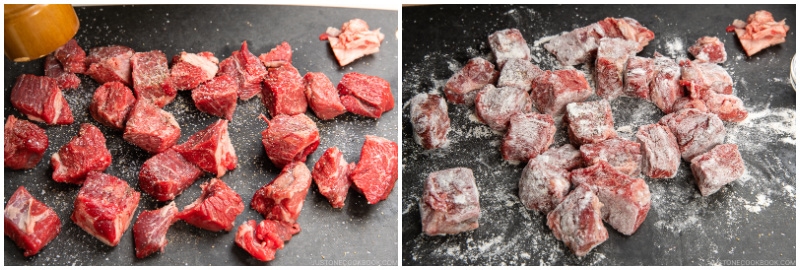
To Sear the Beef
- Preheat a carbon steel pan or cast iron skillet on medium-high heat. When it's hot, add the remaining half of the oil and butter. Cook the beef in 2 batches. Add the beef cubes in a single layer, making sure not to crowd the skillet; otherwise, the excess moisture in the pan will end up steaming the meat.
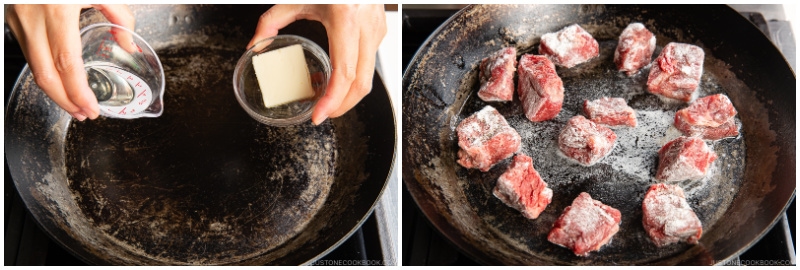
- Sear the beef cubes (do not move them) on one side until brown and crusty, about 3–4 minutes, then turn them over to sear the other sides. The meat will release itself from the pan when the surface is seared nicely. Transfer the seared meat to a plate and work on the next batch.
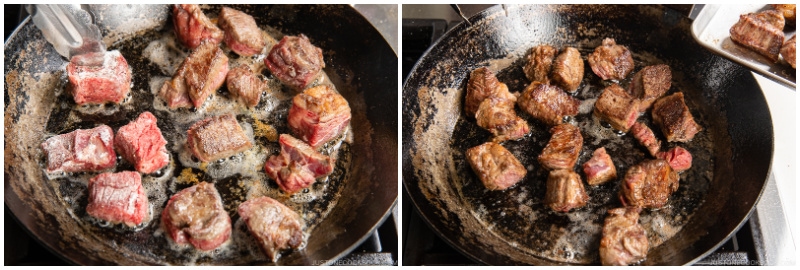
- Once you‘ve seared and transferred all the meat, deglaze the pan. Add ½ cup red wine to the pan and use a wooden blunt-end spatula to scrape and release the flavorful browned bits (the “fond“) that are stuck to the bottom of the pan. Turn off the heat and set aside.
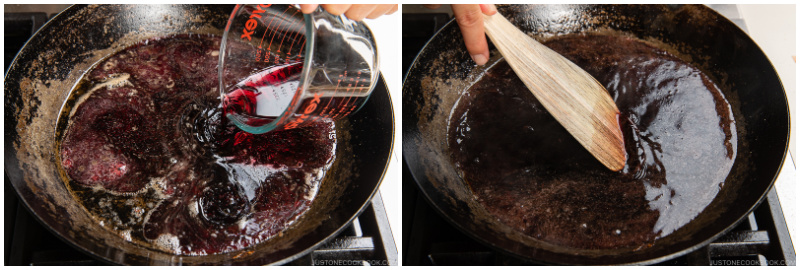
To Cook the Curry
- By now, the onions should be caramelized and ready for the next step. Reheat the pot with the onions on the stove over medium heat. Add the minced garlic (I use a garlic press) and grated ginger.
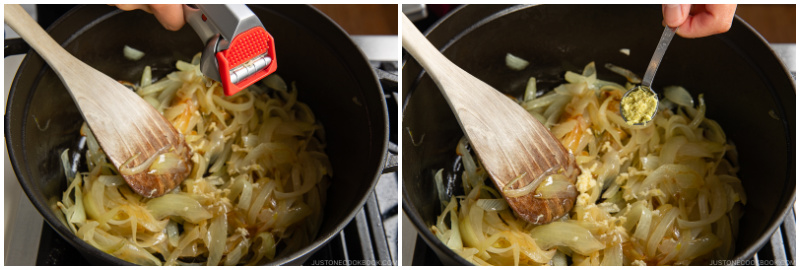
- Add ½ Tbsp Japanese curry powder and 1 Tbsp tomato paste and sauté for 1 minute.
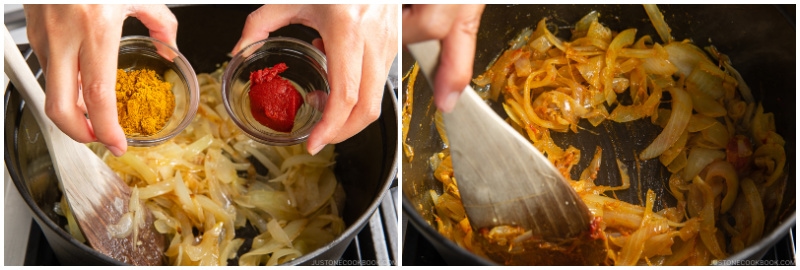
- Add the seared beef, any juices from the plate, and the deglazed pan liquid to the pot and mix them all together. Cook, stirring occasionally, for 3 minutes, letting the alcohol from the wine evaporate.
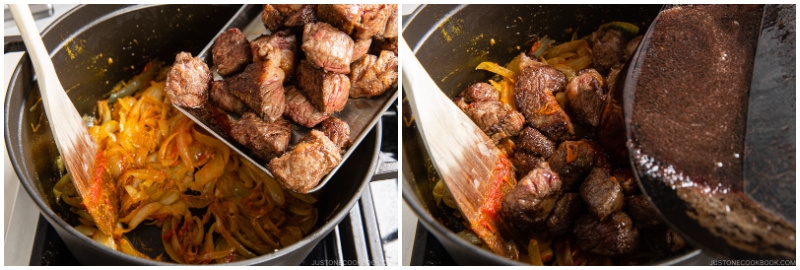
- Add the carrots and mushrooms and mix them all together. Add 4 cups beef stock/broth (or half stock/half water) to just cover the ingredients. Cover the pot with a tight-fitting lid and bring it to a boil. Tip: Compared to Le Creuset, I think Staub lids create a great seal that prevents evaporation.
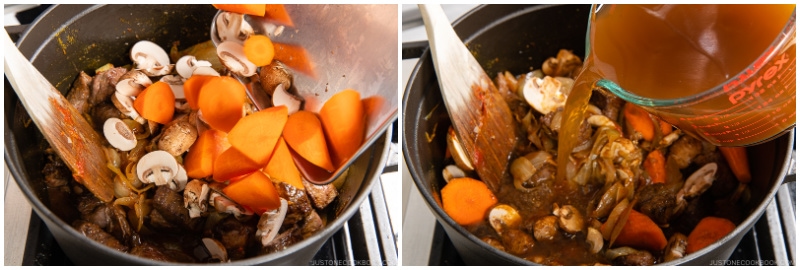
- Once boiling, skim off the scum from the broth's surface. I add water to a 2-cup measuring cup and dip my fine-mesh skimmer in it to rinse off the debris. For full instructions, see my post How To Skim Off the Scum and Fat from Soups and Stocks.
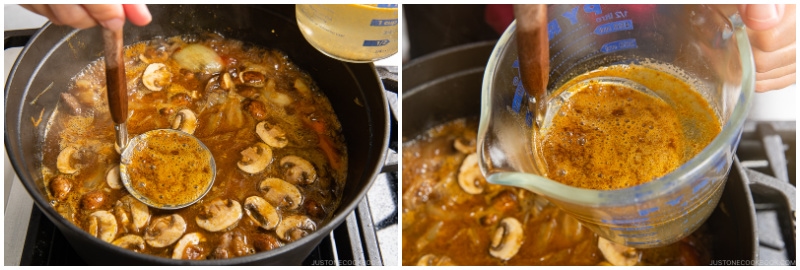
- Grate ⅛ apple and add it to the broth. Then, add 1 Tbsp Worcestershire sauce and 2 Tbsp milk.

- Add 1 bay leaf and cover the pot with the tight-fitting lid. Simmer on low heat until the meat is tender, about 1 hour and 45 minutes. If you do not have a tight-fitting lid, you may need to add more beef stock or water, enough to just cover the ingredients. Tip: To get tender beef, 2 hours of simmering is standard.
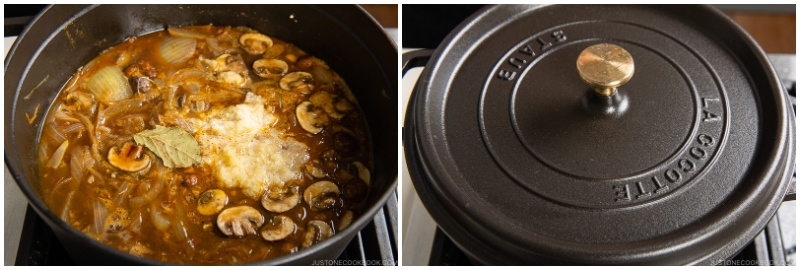
- When the beef is tender, add the potatoes, close the lid, and simmer for 15 minutes until the potatoes are cooked through.
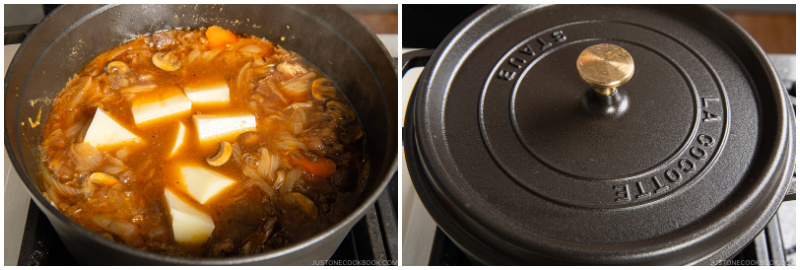
- When the potatoes are tender (and a wooden skewer can pierce through the potato), discard the bay leaf and turn off the heat.
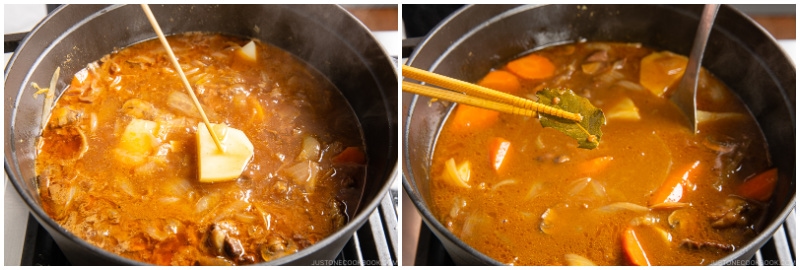
- Add up to 1 package Japanese curry roux off the heat. Put 1–2 cubes of roux in a ladleful of cooking liquid, dissolve it with a spoon or chopsticks, and stir it into the broth to incorporate. Repeat with the remaining roux. Taste as you go and adjust the amount; you may not need to use all of the roux (you can refrigerate or freeze the extra for another use). After adding the curry roux, simmer on the lowest heat, stirring often, for 3–5 minutes until the sauce thickens. Be careful not to burn the sauce! If it‘s too thick, add water to dilute. If it‘s too thin and soupy, uncover the pot and simmer a bit longer.
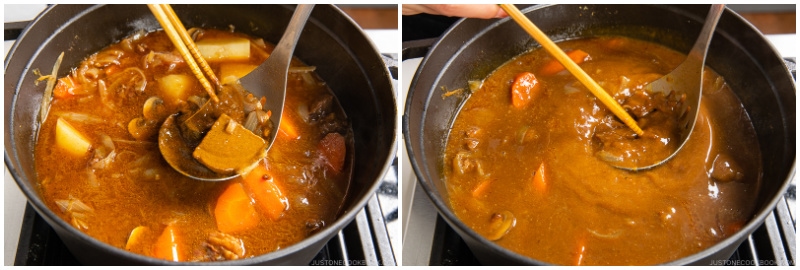
To Serve
- Serve the cooked Japanese short-grain rice on one half of individual plates or shallow bowls. Spoon the beef curry on the other half. Top with optional fukujinzuke (Japanese red pickled vegetables) and rakkyo (Japanese pickled scallion).
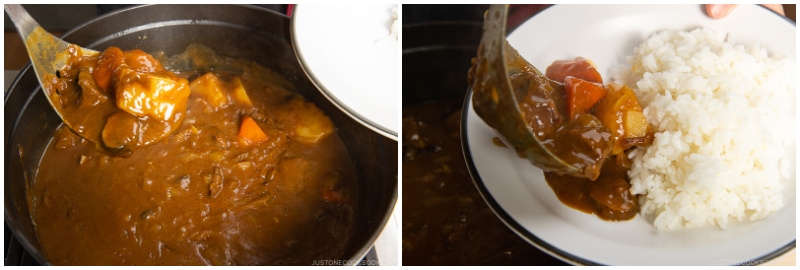
To Store
- Keep the leftovers in an airtight glass container (so no stains!) and store it in the refrigerator for up to 3 days or in the freezer for a month. The texture of the potatoes will change in the freezer, so remove them before freezing. Defrost the frozen curry in the refrigerator for 24 hours before you want to reheat it. If you have any extra roux, keep it in an airtight container and store in the refrigerator or freezer for 1–3 months.
To Reheat
- Leftover curry sauce will thicken into a paste as it cools, so it tends to burn while reheating. To avoid this, stir ½ cup (120 ml) water or more into the leftover sauce until loosened. Then, gently reheat it on low heat. If the sauce seems thin, continue heating with the lid off to reduce the sauce.
Nutrition
Editor’s Note: This post was originally published on April 15, 2011. The recipe instruction was slightly revised with new pictures and video on May 15, 2022. The post was republished with more helpful information on December 12, 2024.
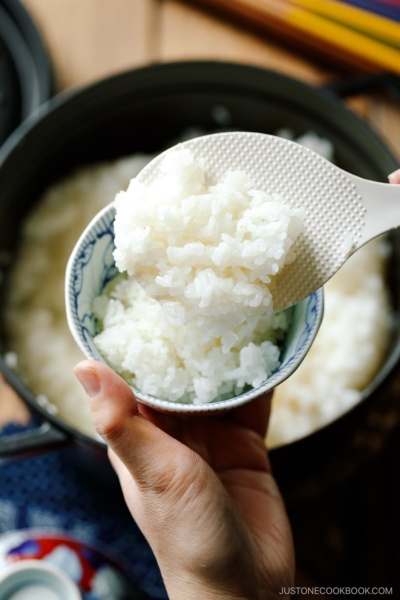
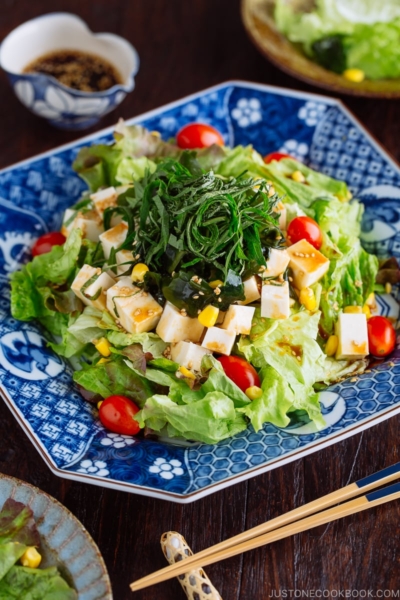
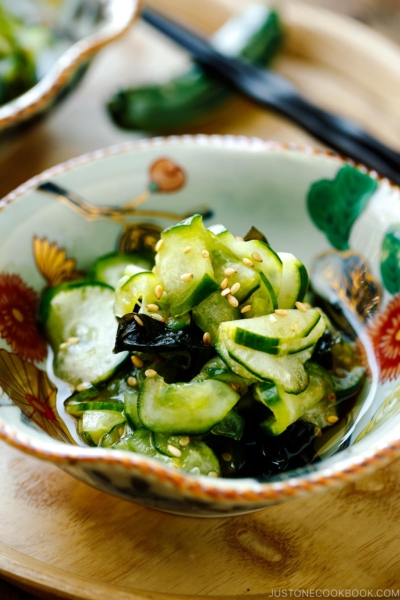






Yum! I made this in my pressure cooker. I cooked it for half an hour, then added the potato for another 10 minutes, then added the roux and just cooked for another 3 minutes. Everything was cooked perfectly and much faster. Your cucumber and Wakame salad was served alongside. The whole family enjoyed it.
Hello, Alex. Wow! Beef curry with cucumber and wakame salad sounds like the perfect meal!
We’re delighted you and your family enjoyed the dishes.🤗 Thank you for trying Nami’s recipes and for your kind feedback! Happy cooking!
I have been eating Japanese style curry rice infrequently through out my life, mostly the instant kind. However, recently I’ve been watching many different Japanese animations that have made many references to the curry rice. Then there were a packet of slightly used S&B curry mix that took up the space in the fridge Which all together led me to your recipe that I substituted the beer for the wine and the coconut milk for the dairy milk. Also I add some brown sugar and the mirin, as per your suggestion, trying to add some flares to the taste. Thank you for this recipe to get me started.
Hello, David. Aww. We are delighted you enjoyed the homemade curry!
Thank you for reading Nami’s post and sharing your cooking experiences with us. We’re pleased to hear Nami’s recipe has inspired you!
Happy cooking!
Amazing curry made it tonight without the apple as i forgot it a supermarket. It was amazing! Tasted even better the next day for lunch!!! 100% recommend!
Hi Daniel! We are happy to hear you enjoyed Nami’s recipe!
Thank you for trying Nami’s recipe and for your kind feedback! 🤗
Made this tonight and the whole family loved it! Great depth of flavour, so yummy! Thank you for this great recipe!
Hi BlueWren! We are so happy to hear everyone enjoyed Nami’s recipe!
Thank you for trying her recipe and for your kind feedback. Happy Cooking!🤗
Absolute best! The perfect combination of flavours.
Hello Taryn! We are so happy to hear you enjoyed this dish!
Thank you for trying Nami’s recipe and for your kind feedback!🤗
I’ve made beef curry in the past but this recipe was the best ever! I did cheat and use apple butter instead of an apple but it worked well. I love the perfect balance of sweetness and spice and the depth of flavor. This is my new “go-to” beef curry recipe.
Hello Arlene! Thank you for your kind feedback!
We are happy to hear you enjoyed Nami’s recipe. Thank you for trying her recipe!